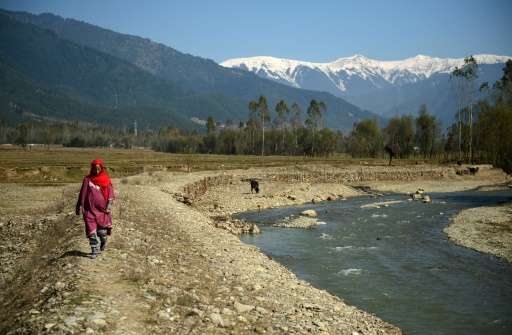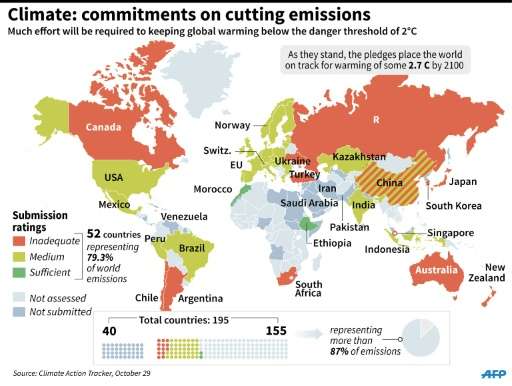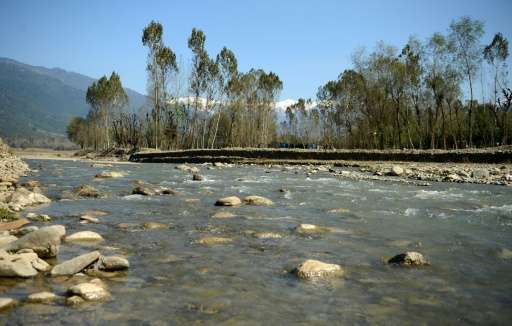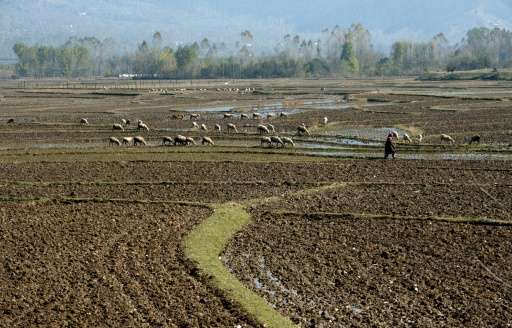Choking air, melting glaciers: how global warming is changing India

Its Himalayan glaciers are melting fast, its agricultural heartland is drying up and its capital is choking on the world's filthiest air.
Yet India's government is one of the few major economies refusing to pledge to cut greenhouse gas emissions, ahead of this month's major climate conference in Paris.
Global warming is already changing the face of rapidly developing India, a nation forecast to become the world's most populous, overtaking China, in less than a decade.
"No one has done less to contribute to global warming than India and Africa. No one can be more conscious of climate change than Indians and Africans," Prime Minister Narendra Modi told a recent Delhi summit.
Melting glaciers
In the Himalayas of Kashmir, scientist Shakil Ahmad Romshoo fears for the future of the pristine region which relies heavily on its more than 100 glaciers for water.
At least two major ones have disappeared completely in the last 50 years, while those in a key basin have shrunk by more than 27 percent over the same period, Romshoo's studies show.
"The impact of climate change in Kashmir is loud and clear. We have noticed a significant decline in stream flow from the glaciers," the glaciologist, from the University of Kashmir, told AFP.
In villages nestled in the foothills downstream, less water flowing into rivers and ponds has forced farmers to completely change their way of life.
Instead of rice paddies dotting the landscape, farmers have switched to growing apples which use less water, raising concerns about a drop in India's grain supplies.
As snow melts faster on the peaks from warmer temperatures, farmers, who have stuck with traditional crops, have been thrown into turmoil.
"All the snow melt on the mountains now melts away by April when we actually start needing it for agriculture," said Haji Mohammad Rajab Dar in Chandigam village.
"I used to get 230 to 260 sacks of rice from my fields. It is reduced to just 90 this year," the 70-year-old said, explaining that his land is not conducive to growing apples.
"So we are ruined and turning into beggars slowly."

Shrinking coastline
India's landscapes are changing—from the melt in the Himalayas, to the increasingly arid farm belts in the middle and the stunning coasts where fishermen talk of rising, warmer seas eroding their shores.
"Changes in sea level and temperature have affected our livelihood. Over the last decade, the amount of fish caught has reduced by 40 percent," said Ayub Hajji whose family has been fishing off Gujarat's coast for generations.
India says developed countries are mostly to blame for climate change, and heaping demands on developing nations to cut emissions is both unfair and hypocritical.
Authorities insist they must focus on meeting the growing needs of its 1.25 billion people, 300 million of whom lack access to electricity.
In its action plan for the Paris COP21 meet, India pledges to reduce its carbon intensity—a measure of a country's emissions relative to its economic output—by 35 percent by 2030, rather than an absolute cut in emissions.
Globally, India is the third largest carbon-emitting country—though its per capita emissions are only one third of the international average—according to the World Resources Institute.
Gasping for breath
While the government has an ambitious programme to ramp its use of renewables, including solar energy, it has also vowed to continue expanding its use of coal.
It plans to double coal production to one billion tonnes by 2020—saying it was vital to meet the needs of its burgeoning economy, which grew seven percent last quarter.
But the increasing emissions are taking their toll on health, with Delhi now officially the world's most polluted capital, a problem compounded by the steady rise in car ownership.

At one of Delhi's leading chest hospitals, Dr Manu Madan said the corridors are full of patients suffering asthma and other ailments linked to the dirty air.
"We see more than 600 patients a day in the out-patients department," said Madan, who normally skips lunch to try to keep the queues down.
Madan said his team from the Vallabhbhai Patel Chest Institute are bracing for winter, when heavy cloud cover traps the pollution.
"Children suffer the most because of less immunity. At least two to three months during the winter are the worst. In many cases, we recommend they move out of Delhi."
Fields dry up
In the fields of western Maharashtra state, large numbers of farmers are reeling from erratic rains which experts suspect are linked to climate change.

Sudden heavy downpours followed by weeks of no rain at all are accelerating topsoil erosion and leading to less fertile and even barren fields, said Shantaram Sakore, director of a local farmers' NGO.
With no access to irrigation and heavily reliant on the annual monsoon, farmers are increasingly competing to dig deeper borewells to tap groundwater to cope with drought.
"Collectively they have depleted the ground water level substantially," said Sakore, calling for more education on climate change.

Rice farmer Narayan Nipurte, from Thane district north of Mumbai, knows little of the complexities of global warming. But he understands the drier monsoons are making it more difficult to feed his family.
"There will be some seasons when there is no rain, so what do you do?" Nipurte asked.
-

Globally, India is the third largest carbon-emitting country—though its per capita emissions are only one third of the international average—according to the World Resources Institute -

In its action plan for the Paris COP21 meet, India pledges to reduce its carbon intensity—a measure of a country's emissions relative to its economic output—by 35% by 2030
© 2015 AFP




















